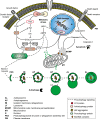Chronic myelogenous leukemia, a still unsolved problem: pitfalls and new therapeutic possibilities
- PMID: 30880916
- PMCID: PMC6415732
- DOI: 10.2147/DDDT.S191303
Chronic myelogenous leukemia, a still unsolved problem: pitfalls and new therapeutic possibilities
Abstract
Chronic myeloid leukemia (CML) is a clonal myeloproliferative disorder of hematopoietic stem cells. At the molecular level, the disorder results from t(9;22)(q34;q11) reciprocal translocation between chromosomes, which leads to the formation of an oncogenic BCR-ABL gene fusion. Instead of progress in the understanding of the molecular etiology of CML and the development of novel therapeutic strategies, clinicians still face many challenges in the effective treatment of patients. In this review, we discuss the pathways of diagnosis and treatment of patients, as well as the problems appearing in the course of disease development. We also briefly refer to several aspects regarding the current knowledge on the molecular basis of CML and new potential therapeutic targets.
Keywords: BCR–ABL; CML; TKI; TKI withdrawal; autophagy; chronic myeloid leukemia; stem cells; tyrosine kinase inhibitors.
Conflict of interest statement
Disclosure The authors report no conflicts of interest in this work.
Figures


Similar articles
-
Chronic Myeloid Leukemia in the Era of Tyrosine Kinase Inhibitors: An Evolving Paradigm of Molecularly Targeted Therapy.Mol Diagn Ther. 2016 Aug;20(4):315-33. doi: 10.1007/s40291-016-0208-1. Mol Diagn Ther. 2016. PMID: 27220498 Review.
-
BCR-ABL inhibitors in chronic myeloid leukemia: process chemistry and biochemical profile.Curr Med Chem. 2011;18(19):2943-59. doi: 10.2174/092986711796150414. Curr Med Chem. 2011. PMID: 21651486 Review.
-
Chronic Myeloid Leukemia (CML) Mouse Model in Translational Research.Methods Mol Biol. 2016;1438:225-43. doi: 10.1007/978-1-4939-3661-8_13. Methods Mol Biol. 2016. PMID: 27150093
-
Pharmacological difference between degrader and inhibitor against oncogenic BCR-ABL kinase.Sci Rep. 2018 Sep 10;8(1):13549. doi: 10.1038/s41598-018-31913-5. Sci Rep. 2018. PMID: 30202081 Free PMC article.
-
BCR-ABL kinase domain mutations in tyrosine kinase inhibitors-naïve and -exposed Southeast Asian chronic myeloid leukemia patients.Exp Mol Pathol. 2012 Apr;92(2):259-65. doi: 10.1016/j.yexmp.2012.01.007. Epub 2012 Jan 31. Exp Mol Pathol. 2012. PMID: 22314255
Cited by
-
A Systematic Literature Review of the Economic Evaluations of Treatments for Patients with Chronic Myeloid Leukemia.Pharmacoeconomics. 2022 Dec;40(12):1159-1186. doi: 10.1007/s40273-022-01189-9. Epub 2022 Sep 30. Pharmacoeconomics. 2022. PMID: 36175789
-
Breakthrough in Degradation of BCR-ABL Fusion Protein for the Treatment of Cancer.ACS Med Chem Lett. 2020 Nov 20;11(12):2359-2360. doi: 10.1021/acsmedchemlett.0c00587. eCollection 2020 Dec 10. ACS Med Chem Lett. 2020. PMID: 33335652 Free PMC article. No abstract available.
-
ASIC1a Inhibitor mambalgin-2 Suppresses the Growth of Leukemia Cells by Cell Cycle Arrest.Acta Naturae. 2020 Apr-Jun;12(2):101-116. doi: 10.32607/actanaturae.10949. Acta Naturae. 2020. PMID: 32742733 Free PMC article.
-
Simultaneous Inhibition of BCR-ABL1 Tyrosine Kinase and PAK1/2 Serine/Threonine Kinase Exerts Synergistic Effect against Chronic Myeloid Leukemia Cells.Cancers (Basel). 2019 Oct 12;11(10):1544. doi: 10.3390/cancers11101544. Cancers (Basel). 2019. PMID: 31614827 Free PMC article.
-
Genetic Biomarkers in Chronic Myeloid Leukemia: What Have We Learned So Far?Int J Mol Sci. 2021 Nov 19;22(22):12516. doi: 10.3390/ijms222212516. Int J Mol Sci. 2021. PMID: 34830398 Free PMC article. Review.
References
-
- Goldman JM. Chronic myeloid leukemia: a historical perspective. Semin Hematol. 2010;47(4):302–311. - PubMed
-
- Deininger MW, Goldman JM, Melo JV. The molecular biology of chronic myeloid leukemia. Blood. 2000;96(10):3343–3356. - PubMed
-
- Bruns I, Czibere A, Fischer JC, et al. The hematopoietic stem cell in chronic phase CML is characterized by a transcriptional profile resembling normal myeloid progenitor cells and reflecting loss of quiescence. Leukemia. 2009;23(5):892–899. - PubMed
-
- Shet AS, Jahagirdar BN, Verfaillie CM. Chronic myelogenous leukemia: mechanisms underlying disease progression. Leukemia. 2002;16(8):1402–1411. - PubMed
Publication types
MeSH terms
Substances
LinkOut - more resources
Full Text Sources
Medical
Miscellaneous

